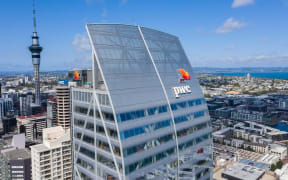
The likes of Amazon aim to open a dozen data centres. Photo: 123rf
Just how much power will new massive data centres gobble up, and what will be the impact on your power bill or the national grid?
It turns out government officials in charge of the country's energy strategy have not been keeping a close count.
Asked what the very latest forecasts show about electricity demands from the dozen data centres the likes of Amazon aim to open, the Ministry of Business, Innovation and Employment (MBIE) sent RNZ a ministerial briefing from eight months ago.
The briefing cites a single study - not by MBIE but a consultant for Trade and Enterprise - with a forecast from early 2022.
That is for total data centre demand of 220MW by 2030 - to compare, Auckland uses 1700MW - up three times from about 50MW now.
But there are gathering signs it could be much more than that.
Plans for three new data centers in Auckland are not factored in, from operators CDC - adding two more to two it has just opened - and nor is this year's new arrival NextDC. Transpower is expecting Southland's Datagrid centre to be at 100MW from next year. That all adds up to well above the 2022 forecast.
"This is a fast growing industry and developers' plans evolve rapidly so load cannot always be accurately forecast," Transpower said in a new report.
CDC alone has expanded data capacity in Australasia almost 10 times since 2016, and the "explosion" of demand was "showing no sign of slowing", CDC's part-owner, New Zealand investor Infratil said in March.
Amazon and Microsoft were each up for using at least 50MW or so in their handful of under-construction centres.
Transpower has logged 16 fresh inquiries from data centres, 11 to connect to lines and five direct into the grid. Who these were from was confidential.
MBIE gave the 220MW forecast to Energy Minister Megan Wood, who was juggling massive capacity demands, and was relying on the ministry to come up with a first-ever, emissions reducing energy strategy. Strategy documents online said little or nothing about data centres.
The ministry reiterated to RNZ last week its message to Wood eight months ago:
"We spoke to industry about the range of scenarios cover[ed] in the briefing, and we consider that the potential demand from data centres is being adequately factored into long-term planning," it said.
RNZ contacted industry players who indicated they had not specifically engaged with the ministry over data centres.
Transpower said it had discussed the 2022 study with the ministry back in February and "advised that the data centre demand forecasts were not inconsistent with our conversations" with distributors "at that time".
Transpower's new 413-page transmission planning report has only a few paragraphs devoted to data centres:
"The most visible new industry being attracted to New Zealand due to its largely renewable generation are data centres and hydrogen production," it said.
Existing data centre demand was factored in but "large and hyperscale data centres may require new, dedicated, grid exit points" - a cost to the grid.
Without upgrades, grid exit points to local lines in north Auckland - a data centre hotspot - would be overloaded by 2028, the ministerial briefing showed.
"Our load forecasts do not include any hyperscale data centres," Transpower said.
It was not clear how hypescalers were defined by it, but most of those planned describe themselves this way.
What about consumers?
The ministerial briefing said data centres would not compete with homes for connections, as they both used the grid but different lines.
However, it alluded to data centre operators getting special power deals, at least in Southland.
Part of New Zealand's attraction was sustainable electricity generation, with Amazon and Microsoft recently trumpeting 'green energy' deals of about 50MW each with gentailers Mercury and Contact.
The briefing told Wood Southland was competing with Tasmania, where spot power was one-fifth the price.
Cloud computing providers "would need to negotiate very competitive contracts with electricity suppliers to bridge the value proposition with Tasmania".
That has echoed in the series of sweet power deals inked over the years to keep massive power-user Tiwai Pt aluminium smelter here - consumers had subsidised the smelter's power at a rate of about $200 per household a year, according to the Electricity Authority.
If the smelter exited in 2034, that would free up some power for data centres, Transpower said.
The hyperscalers argue their centres were more energy-efficient than smaller data centres so that was the more sustainable way to increase capacity.
MBIE has defended its overview based on what power distributors were saying: "There are not currently concerns about shortfalls in generation capacity to meet increased demand from data centres".
"Additionally, the entry of new data centres has the potential to support new renewable generation development."






